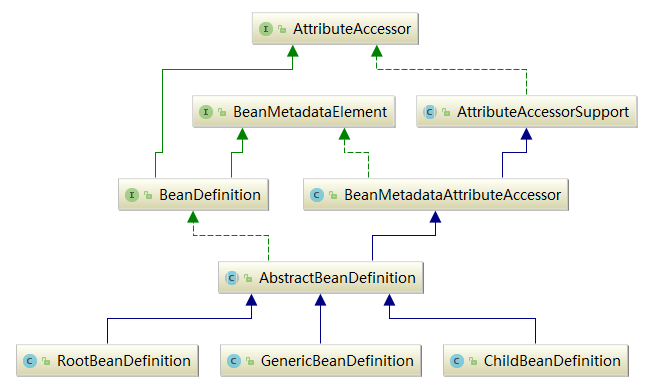Creation of BeanDefinitionHolder
The inheritance structure of BeanDefinition in the Spring framework is as follows:

BeanDefinition is the internal representation of the configuration file < bean > element label in the container. The < bean > element tag has class, scope, lazy init and other configuration attributes, while BeanDefinition provides the corresponding beanClass, scope, lazyInit attributes. The attributes in BeanDefinition and < bean > correspond one by one.
When creating a BeanDefinition, you can generate instances of RootBeanDefinition or GenericBeanDefinition or ChildBeanDefinition. But now most of the time it's creating instances of GenericBeanDefinition.
- RootBeanDefinition: the most commonly used implementation class, which corresponds to the general < bean > element label;
- Genericbean definition: it is a newly added bean file configuration attribute definition class since 2.5, which is a one-stop service class;
- ChildBeanDefinition: in the configuration file, the parent < bean > and the child < bean > can be defined. The parent < bean > is represented by RootBeanDefinition, while the child < bean > is represented by ChildBeanDefinition, while the < bean > without the parent < bean > is represented by RootBeanDefinition. AbstractBeanDefinition abstracts the common class information of the two.
Processing stage in the loading, parsing, processing and registration of BeanDefinition . You need to create a BeanDefinitionHolder object. The creation process is as follows:
-
processBeanDefinition in the DefaultBeanDefinitionDocumentReader class calls the method by which the agent creates the BeanDefinitionHolder object
-
protected void processBeanDefinition(Element ele, BeanDefinitionParserDelegate delegate) {
BeanDefinitionHolder bdHolder = delegate.parseBeanDefinitionElement(ele);
if (bdHolder != null) {
bdHolder = delegate.decorateBeanDefinitionIfRequired(ele, bdHolder);
try {
// Register the final decorated instance.
BeanDefinitionReaderUtils.registerBeanDefinition(bdHolder, getReaderContext().getRegistry());
}
catch (BeanDefinitionStoreException ex) {
getReaderContext().error("Failed to register bean definition with name '" +
bdHolder.getBeanName() + "'", ele, ex);
}
// Send registration event.
getReaderContext().fireComponentRegistered(new BeanComponentDefinition(bdHolder));
}
} -
In the BeanDefinitionParserDelegate class
-
@Nullable
public BeanDefinitionHolder parseBeanDefinitionElement(Element ele) {
return parseBeanDefinitionElement(ele, null);
} -
@Nullable
public BeanDefinitionHolder parseBeanDefinitionElement(Element ele, @Nullable BeanDefinition containingBean) {
String id = ele.getAttribute(ID_ATTRIBUTE);
String nameAttr = ele.getAttribute(NAME_ATTRIBUTE);List<String> aliases = new ArrayList<>();
if (StringUtils.hasLength(nameAttr)) {
String[] nameArr = StringUtils.tokenizeToStringArray(nameAttr, MULTI_VALUE_ATTRIBUTE_DELIMITERS);
aliases.addAll(Arrays.asList(nameArr));
}String beanName = id;
if (!StringUtils.hasText(beanName) && !aliases.isEmpty()) {
beanName = aliases.remove(0);
if (logger.isTraceEnabled()) {
logger.trace("No XML 'id' specified - using '" + beanName +
"' as bean name and " + aliases + " as aliases");
}
}if (containingBean == null) {
checkNameUniqueness(beanName, aliases, ele);
}//Create BeanDefinition object here
AbstractBeanDefinition beanDefinition = parseBeanDefinitionElement(ele, beanName, containingBean);
if (beanDefinition != null) {
if (!StringUtils.hasText(beanName)) {
try {
if (containingBean != null) {
beanName = BeanDefinitionReaderUtils.generateBeanName(
beanDefinition, this.readerContext.getRegistry(), true);
}
else {
beanName = this.readerContext.generateBeanName(beanDefinition);
// Register an alias for the plain bean class name, if still possible,
// if the generator returned the class name plus a suffix.
// This is expected for Spring 1.2/2.0 backwards compatibility.
String beanClassName = beanDefinition.getBeanClassName();
if (beanClassName != null &&
beanName.startsWith(beanClassName) && beanName.length() > beanClassName.length() &&
!this.readerContext.getRegistry().isBeanNameInUse(beanClassName)) {
aliases.add(beanClassName);
}
}
if (logger.isTraceEnabled()) {
logger.trace("Neither XML 'id' nor 'name' specified - " +
"using generated bean name [" + beanName + "]");
}
}
catch (Exception ex) {
error(ex.getMessage(), ele);
return null;
}
}
String[] aliasesArray = StringUtils.toStringArray(aliases);
return new BeanDefinitionHolder(beanDefinition, beanName, aliasesArray);
}return null;
-
@Nullable
public AbstractBeanDefinition parseBeanDefinitionElement(
Element ele, String beanName, @Nullable BeanDefinition containingBean) {this.parseState.push(new BeanEntry(beanName));
String className = null;
if (ele.hasAttribute(CLASS_ATTRIBUTE)) {
className = ele.getAttribute(CLASS_ATTRIBUTE).trim();
}
String parent = null;
if (ele.hasAttribute(PARENT_ATTRIBUTE)) {
parent = ele.getAttribute(PARENT_ATTRIBUTE);
}try {
AbstractBeanDefinition bd = createBeanDefinition(className, parent);parseBeanDefinitionAttributes(ele, beanName, containingBean, bd);
bd.setDescription(DomUtils.getChildElementValueByTagName(ele, DESCRIPTION_ELEMENT));parseMetaElements(ele, bd);
parseLookupOverrideSubElements(ele, bd.getMethodOverrides());
parseReplacedMethodSubElements(ele, bd.getMethodOverrides());parseConstructorArgElements(ele, bd);
parsePropertyElements(ele, bd);
parseQualifierElements(ele, bd);bd.setResource(this.readerContext.getResource());
bd.setSource(extractSource(ele));return bd;
}
catch (ClassNotFoundException ex) {
error("Bean class [" + className + "] not found", ele, ex);
}
catch (NoClassDefFoundError err) {
error("Class that bean class [" + className + "] depends on not found", ele, err);
}
catch (Throwable ex) {
error("Unexpected failure during bean definition parsing", ele, ex);
}
finally {
this.parseState.pop();
}
return null;
} -
protected AbstractBeanDefinition createBeanDefinition(@Nullable String className, @Nullable String parentName)
throws ClassNotFoundException {return BeanDefinitionReaderUtils.createBeanDefinition(
parentName, className, this.readerContext.getBeanClassLoader());
}
-
-
In the BeanDefinitionReaderUtils class
- BeanDefinition instance created
-
public static AbstractBeanDefinition createBeanDefinition(
@Nullable String parentName, @Nullable String className, @Nullable ClassLoader classLoader)
throws ClassNotFoundException {GenericBeanDefinition bd = new GenericBeanDefinition();
bd.setParentName(parentName);
if (className != null) {
if (classLoader != null) {
bd.setBeanClass(ClassUtils.forName(className, classLoader));
}
else {
bd.setBeanClassName(className);
}
}
return bd;
}
- That's how to create a bean definition during the processing phase.